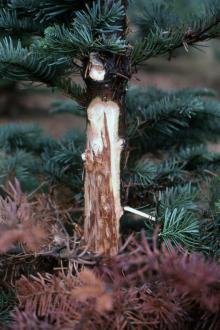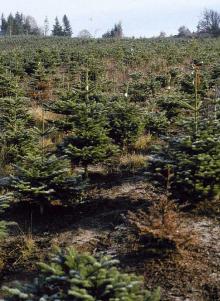See:
Fir, True (Abies spp.) - Shoot Blight
Cause Phytophthora spp., a water mold, fungus-like microorganism. There are several species of Phytophthora that have been associated with root rot development on noble fir in Oregon and Washington Christmas-tree plantations. The dominant species was P. cambivora in a 2012 to 2013 survey, which had changed from a previous survey in 1990. The earlier survey found 7 species dominated by P. cambivora, P. cryptogea, P. gonapodyides, and P. megasperma. When the 2012 to 2013 survey included other true firs such as grand and Fraser fir, P. gonapodyides and P. pseudosyringae were added to the list. These organisms produce swimming spores called zoospores. Generally, a problem on poorly drained sites or areas where water flows through a plantation. Most trees die within the first 3 to 4 years of planting. Although balsam, Fraser, grand, noble, Nordmann, Shasta, Turkish and white firs can be infected, Nordmann and Turkish firs are considered resistant while noble fir is considered the most susceptible. Disease resistant trees may become infected when grown in warmer areas and in the presence of P. cinnamomi. Nursery infection can occur but symptoms may not show until planted in the landscape.
Symptoms One to several roots become infected and die. The fungus continues to invade the root crown or collar causing the cambium and phloem to become a red-brown or butterscotch color. Seedlings often die, older trees may develop necrotic cankers, which are also dark red to dark brown. There generally is a sharp line between infected and healthy tissues. Stem cankers are narrow, long, and may spiral up the tree starting from the infected root and root crown area. Bark splits and pitch may accompany necrotic cankers. Lower branches may wilt and die, with needles turning dark red. Apical growth is also diminished. Use a pocket knife to determine where the canker is coming from to distinguish it from Grovesiella canker.
Sampling Late season sampling was best for recovery of the pathogen in Pennsylvania.
Cultural control
- Plant healthy stock plants. Destroy plants with rotting roots before planting.
- Improve soil drainage.
- Avoid planting in waterways, ditches, and poorly drained soil.
- Do not track or move soil from infected sites to other areas of the plantation.
- Plant less susceptible tree species such as Douglas-fir or resistant Nordman or Turkish fir. Graft susceptible scion onto resistant rootstock such as Fraser scion on momi fir rootstock.
- Avoid reusing pots from a previous crop for propagation. If pots must be reused then wash off all debris and soak in a sanitizing solution or treat with aerated steam for 30 min.
Chemical control Use in conjunction with cultural controls. Rotate between materials from different groups with different modes of action to prevent or delay the development of resistant fungi. Applications of fungicides in noble fir Christmas tree plantations have not generally been effective in controlling this disease. Limited success was obtained on Fraser fir in North Carolina when conditions were not conducive to disease development. Chemical control may only be effective if disease occurs late in the production cycle.
- Adorn at 1 to 4 fl oz/100 gal water plus another fungicide for conifers grown in many different situations including as Christmas trees or ornamentals grown indoors or outdoor landscapes. Group 43 fungicide. 12-hr reentry.
- Aliette for conifer nurseries. Do not use with adjuvants. Group P7 fungicide. 24-hr reentry.
- Soak transplants in 2.5 lb/100 gal water.
- Foliar application of 2.5 to 5 lb/100 gal water. Do not apply less than 30 days apart.
- Fosphite at 1 to 2 quarts/100 gal water. Do not use copper products within 20 days of treatment and do not use spray adjuvants. Registered for conifers in commercial nurseries, plantations, forests, landscapes, and parks including Christmas trees. Group P7 fungicide. 4-hr reentry.
- Monterey Garden Phos at 16 fl oz in 16 fl oz water plus 1 oz Pentra-Bark as a basal trunk spray. Also labeled for injection, see label for details. Can be used in landscape sites. Group P7 fungicide. H
- OxiPhos at 1.3 to 4 quarts/100 gal water as a foliar spray. Registered for conifers grown in field or commercial greenhouses. Group P7 fungicide. 4-hr reentry.
- Phospho-Jet at 1 to 2 quarts/100 gal water as a soil drench. Group P7 fungicide. 4-hr reentry.
- Phostrol at 26 to 54 fl oz/100 gal water used as a foliar spray. Also labeled as a soil drench or root dip, see label for details. Registered for conifers in commercial nurseries, plantations, and forested areas including Christmas trees. Group P7 fungicide. 4-hr reentry.
- Subdue MAXX or Mefenoxam 2 AQ as described below. Do not use as a curative treatment. Registered for conifers in nurseries and plantations including Christmas trees. Group 4 fungicides. 48-hr reentry. No restrictions on reentry when used as a soil drench.
- Seedbeds and plug-plantings: Apply 1.25 pints/A as a broadcast. Spray over beds in at least 50 gal water at seeding or transplanting. Apply again at 6-month intervals.
- Newly transplanted 2-year-old seedlings: Apply 2.5 pints/A as a broadcast. Spray over beds in at least 50 gal water at transplanting. Reapply at about 6-month intervals.
- Conifers in plantations. Use 0.63 to 1.25 gal/A under trees when rain is expected within 3 days. May not be effective on older, already infected trees.
References Benson, D.M., Sidebottom, J.R. and Moody, J. 2006. Control of Phytophthora root rot in field plantings of Fraser Fir with fosetyl-Al and mefenoxam. Online. Plant Health Progress doi:10.1094/PHP-2006-0331-01-RS.
Hinesley, E., and Frampton, J. 2002. Grafting Fraser fir onto rootstocks of selected Abies species. HortScience 37:815-818.
McKeever, K.M., and Chastagner, G.A. 2019. Interactions between root rotting Phytophthora, Abies christmas trees, and environment. Plant Disease 103:538-545.





